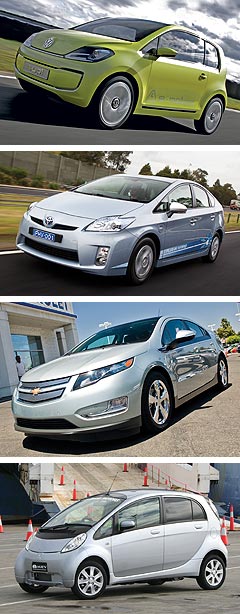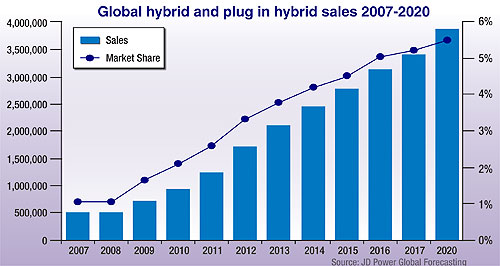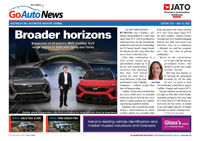News - General News - Electric VehiclesGlobal hybrid, EV boom ‘more hope than reality’Game changer: JD Power expects Nissan-Renault to own a third of the global EV market by 2020, thanks to pioneering models already in production, such as the Leaf. JD Power study concludes global hybrid and EV take-up by 2020 looks to be overhyped5 Nov 2010 By TERRY MARTIN GLOBAL consumer demand for hybrid and electric vehicles looks to be overhyped and is likely to account for only a small proportion of total vehicle sales over the next decade, despite multi-billion-dollar investments and fast-paced development in the car industry, according to a new forecast by global marketing information company JD Power and Associates. In a report titled ‘Drive Green 2020: More Hope than Reality’, JD Power expects that hybrids and EVs will account for just 7.3 per cent – or 5.2 million units – of the 70.9 million passenger vehicles forecast to be sold in 2020. Auto giants leading the charge in electric vehicle development and rollout have more optimistic predictions, such as Nissan-Renault expecting EVs alone to account for around 10 per cent of total vehicle sales by the end of the decade – far in excess of the 1.8 per cent predicted by JD Power.  From top: Volkswagen E-Up!, Toyota Prius PHV, Chevrolet Volt, Mitsubishi i-MiEV. From top: Volkswagen E-Up!, Toyota Prius PHV, Chevrolet Volt, Mitsubishi i-MiEV.BMW also believes EVs alone will account for between five and 15 per cent of the new-vehicle market by 2020, while Volkswagen, which has designs on becoming the world’s top car-maker during this period, expects three per cent of its sales being purely electric vehicles by 2020 – which should be well in excess of 300,000 units. In its report, JD Power, on the other hand, sees the Volkswagen Group accounting for less than 80,000 of global EV sales by 2020, with a 6.0 per cent share of total market of just 1.31 million units. Individual countries, too, are fuelling desire for a massive influx of fossil-free vehicles. The German government, for example, unveiled a cabinet-approved ‘national electro-mobility plan’ in August that calls for a million electric cars on German roads by 2020, and more than five million by 2030. But following research from consulting firm Deloitte in August, which estimated that the EV sales in the US in 2020 would account for just 3.1 per cent (or around 465,000 units) of total automotive sales in that market, JD Power’s study concludes that it will be difficult to convince large numbers of consumers around the world to switch from conventionally powered passenger vehicles to either hybrids or EVs. “While considerable interest exists among governments, media and environmentalists in promoting HEVs (hybrid electric vehicles) and BEVs (battery electric vehicles), consumers will ultimately decide whether these vehicles are commercially successful or not,” said JD Power’s senior vice-president of automotive operations, John Humphrey. “Based on our research of consumer attitudes toward these technologies – and barring significant changes to public policy, including tax incentives and higher fuel economy standards – we don’t anticipate a mass migration to green vehicles in the coming decade.” JD Power says that regulatory inconsistencies across markets, relatively stable oil prices and consumer concerns about cost and ease of operation are barriers for sales of hybrids and EVs. Accordingly, mass migration to alternative powertrain technologies will likely require a massive global oil price rise and/or a substantial breakthrough in technology that will reduce costs and improve consumer confidence. The study also highlights the importance of co-ordinated government policy to encourage consumers to purchase these vehicles, although JD Power notes that “based on currently available information, none of these scenarios are believed to be likely during the next 10 years”. The latter situation is a case in point for Australia, with the federal government refusing to offer incentives to vehicle importers of EVs or other green vehicles at the expense of the local car industry. The JD Power study has forecast that in 2010, global hybrid and EV sales will total 954,500, or 2.2 per cent of the 44.7 million vehicles projected to be sold through to the end of this year. With EVs still a fledgling industry, the vast majority of these – some 934,000 – will be hybrids, mostly from Toyota (64 per cent) and Honda (25 per cent) and with sales concentrated in two countries: Japan (446,000 units) and the US (328,000). Sales of the remaining 15 per cent (140,000) will be scattered in small pockets around the world. Based on VFACTS figures for the first 10 months of this year, Australian hybrid sales in 2010 will be around 9200. Of the 5.2 million hybrids and EVs expected to be sold by 2020, 3.88 million are expected to be hybrids – and 75 per cent of these are forecast to be produced across five manufacturer groups: Toyota, Honda, Hyundai, Volkswagen and General Motors. The leading markets for hybrids by the end of the decade are expected to be the US (1.7 million units), Europe (977,000) and Japan (875,000). Australia will be among the remaining markets, which combined will make up about 11 per cent. China is expected to sell fewer than 100,000 hybrids in 2020. It is, however, expected to account for 332,000 of the 1.3 million EV sales forecast in 2020, which is behind Europe (on 742,000, a figure that makes the German government’s plan look optimistic) but ahead of both the US and Japan (both on around 100,000 units). The rest of the world, including Australia, is expected to share in around six per cent of total EV sales, or around 78,000 units. This year, EV sales are forecast to reach just 20,150 units worldwide, increasing to almost 640,000 units by 2015 and then doubling to 1.31 million by 2020. While this looks to be rapid growth, JD Power says that projected global EV sales in 2020 would account for only 1.8 per cent of the 70.9 million passenger vehicles expected to be sold that year. Ever-tightening emissions laws are the key reason behind Europe’s prominence in the EV forecasts, although China is also expected to become a significant contender in EV production. More than 30 global manufacturers are expected to be building and selling EVs by 2020, but only one – the Nissan-Renault Group – is expected to have more than a double-digit share of the global EV market by that time. JD Power expects Nissan-Renault to own 34 per cent of the EV market in 2020, followed by PSA Peugeot Citroen (6.1 per cent) and Volkswagen (6.0). It gives Mitsubishi 5.0 per cent and Fiat-Chrysler 4.0 per cent, but BMW (which will launch its Megacity in 2013), Toyota and the China’s Chery are expected to have only a 3.0 per cent share, while Daimler, Ford, GM, Hyundai, Honda and China’s Changan Automobile are forecast to hold just a 2.0 per cent claim on the global EV market. In essence, China is seen as the wild card in determining the actual uptake of hybrid and electric vehicles over the next decade, given its rise as the world’s biggest automotive market and its ever-increasing influence on global car manufacturing. JD Power says China has the ability to move quickly, invest heavily in the development of one specific propulsion technology, and mandate fuel economy or emissions standards that could favour a particular technology or require a minimum sales penetration level for vehicles with a designated technology. It says that “given the size and growth rate of the Chinese auto market, such a co-ordinated regulatory environment might allow Chinese companies to achieve economies of scale and drive down the cost of alternative-energy vehicles”.  Read more |
Click to shareGeneral News articlesResearch General News Motor industry news |
















Facebook Twitter Instagram